Research - (2021) Volume 9, Issue 10
Psychosocial Behavioural Changes of Public during Pandemics
Aathira CM and Lakshminarayanan Arivarasu*
*Correspondence: Lakshminarayanan Arivarasu, Department of Pharmacology, Saveetha dental college, Saveetha Institute of Medical and Technical Sciences, India, Email:
Abstract
The severe acute respiratory syndrome–coronavirus-2 pandemic has spread rapidly and has a growing impact on individuals, communities, and healthcare systems worldwide. At times of any pandemic, the role and responsibility of the authorities to react accordingly changes the outcome of the situation. Hand hygiene and social distancing behaviours must be implemented. Successfully reaching this goal requires both individual and collective efforts to drastically modify daily routines and activities. The aim of this study is to assess the psychosocial behavioural changes during pandemic. 100 people were chosen for the study from the Chennai district. A cross sectional study consisting of 15 questions was circulated online and the data was statistically analysed using SPSS software. Statistical analysis was done using Chi square tests. It is clear from the results that the public gets stressed and is loaded with misleading information throughout the pandemic. Hence, people are repellent towards healthcare policies and deny them. It can be concluded that proper awareness and trust must be created among the public for their wellbeing and to work out new strategies to enhance and handle pandemic outbreaks.
Keywords
Pandemic, Response, Public, Psychosocial behaviour
Introduction
Several previous studies have investigated the attitudinal, cognitive, and behavioral impact of pandemics and global outbreaks on diverse populations. The results obtained from this study can be applied and implemented during pandemics to optimize better communication and preventive measures to people during their difficult times [1]. When it comes down to pandemics, myths, misconceptions, and risk factors play an important role among people which fear them and traumatise them a lot. To prevent this effective communication must be practised [2]. Lack of knowledge and awareness among the public can also lead to problems during pandemics among the population [3].The control of any disease easily depends on the response, attitude, and knowledge regarding the topic among the public towards it [4]. Precautionary measures have been made strict and compel people to follow them during pandemics [5]. Thus, people are influenced by false information regarding the situation and so they are now in a state that they are confused, anxious and crave for helpful and leading information regarding the situation they are undergoing [6]. It is important to understand the knowledge, attitude and awareness regarding the measures initiated by the government that tends to affect their daily activities in a couple of ways [7]. This can be achieved by understanding the awareness and knowledge level of the public [8].
There prevails a lot of confusion regarding the spread and mode of transmission of the virus itself [9]. This presents an additional challenge to be faced and cleared among the confused population [10]. The knowledge, attitudes, and practices (KAP) toward COVID-19 play an integral role in determining a society’s readiness to accept behavioural change measures from health authorities [11,12]. Misinformation regarding the facts and recent updates can have lasting impacts, including reduced engagement with vaccination once it becomes available [13]. Both elevated anxiety and trust in information provided by authorities have been shown to predict health-protective behaviors during infectious disease outbreaks [14]. Misinformation and misleading updates and theories regarding COVID-19 are also widespread and evolving [15]. Taking into consideration the current situation creates an alarming fear and anxiety among the general public at times of pandemic. Our team has extensive knowledge and research experience that has translate into high quality publications [16-35]. This study was conducted to assess the psychosocial behaviour of the public during pandemics.
Materials and Methods
Study design
The study was designed to include the general public of Chennai district. The participants who did not fall under this inclusion criteria and those not interested were excluded.
Sampling technique
This study was a cross sectional study, conducted in a Chennai population of the general public. A total of 100 participants were involved in this study. The duration of the study was from January to March 2021.The participants of the study were randomly selected 100 people from Chennai. The participants below 18 years of age were excluded from the study.
Inclusion criteria
• Randomly selected 100 people.
• Voluntary participants willing to give informed consent.
Exclusion criteria
• Participants below 18 years of age.
• Unwilling participants.
Questionnaire
A validated questionnaire of 20 questions related to facts regarding pandemics especially COVID 19 and questions related to their mental health was prepared. The questionnaire was structured, close ended and designed in English language. There were three sections of the questionnaire. The first section covered the demographic profile including details regarding age, sex, and education. Section two had eight questions regarding knowledge and awareness regarding pandemics. Section three had 14 questions regarding their mental state and strategies to be followed during outbreaks.
Statistical analysis
The variables were coded and the data was imported to SPSS Version 20 categorical variables were expressed in terms of frequency and bar graphs were plotted. The statistical significance of the associations were tested using Chi square tests.
Results
Results are mentioned in figures (Figures 1 to Figure 5).
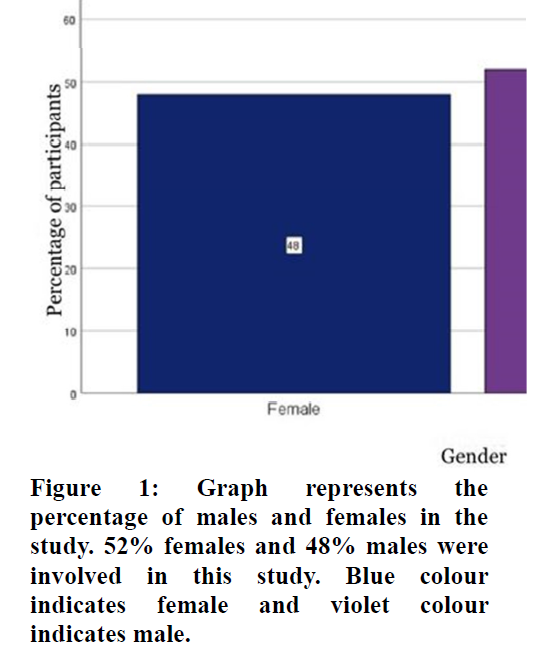
Figure 1. Graph represents the percentage of males and females in the study. 52% females and 48% males were involved in this study. Blue colour indicates female and violet colour indicates male.
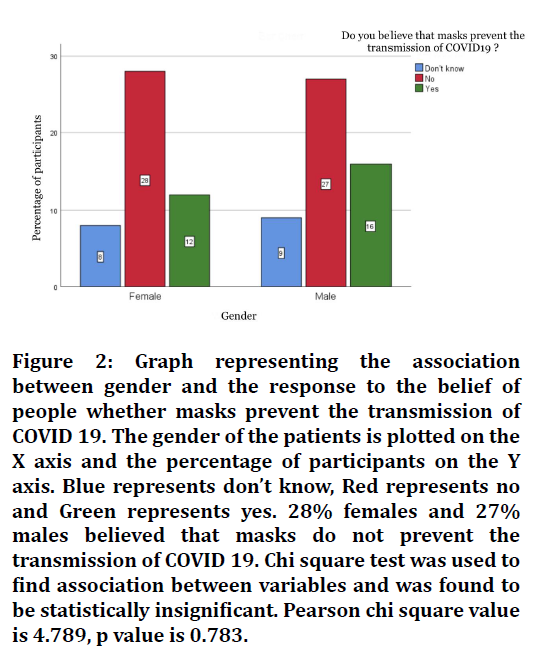
Figure 2. Graph representing the association between gender and the response to the belief of people whether masks prevent the transmission of COVID 19. The gender of the patients is plotted on the X axis and the percentage of participants on the Y axis. Blue represents don’t know, Red represents no and Green represents yes. 28% females and 27% males believed that masks do not prevent the transmission of COVID 19. Chi square test was used to find association between variables and was found to be statistically insignificant. Pearson chi square value is 4.789, p value is 0.783.
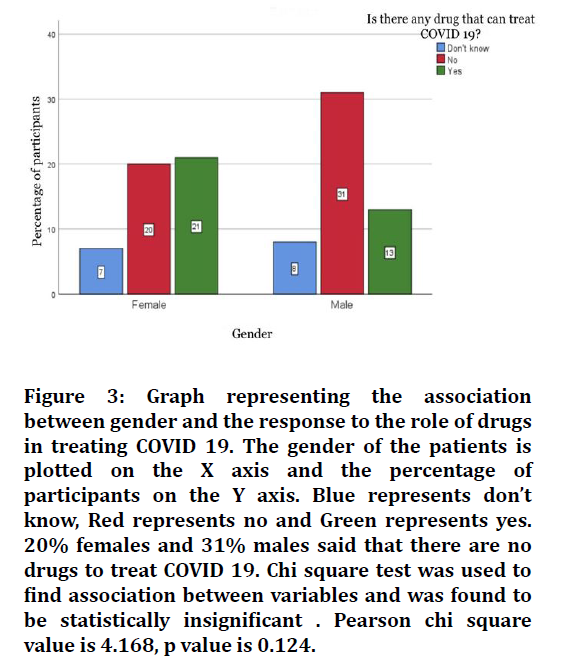
Figure 3. Graph representing the association between gender and the response to the role of drugs in treating COVID 19. The gender of the patients is plotted on the X axis and the percentage of participants on the Y axis. Blue represents don’t know, Red represents no and Green represents yes. 20% females and 31% males said that there are no drugs to treat COVID 19. Chi square test was used to find association between variables and was found to be statistically insignificant . Pearson chi square value is 4.168, p value is 0.124.
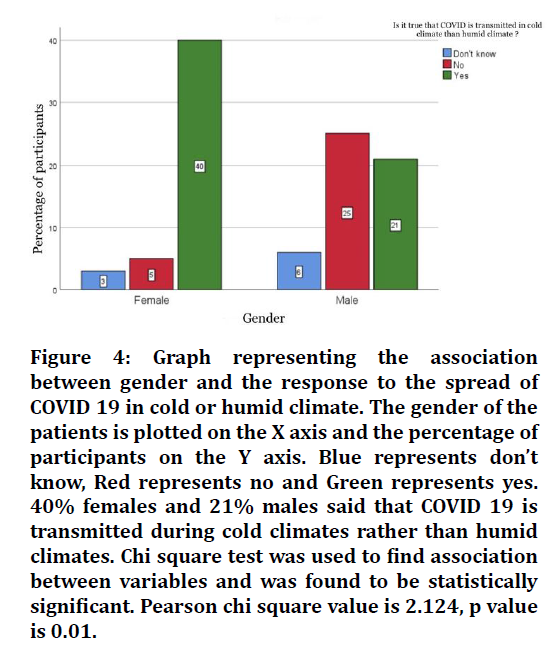
Figure 4. Graph representing the association between gender and the response to the spread of COVID 19 in cold or humid climate. The gender of the patients is plotted on the X axis and the percentage of participants on the Y axis. Blue represents don’t know, Red represents no and Green represents yes. 40% females and 21% males said that COVID 19 is transmitted during cold climates rather than humid climates. Chi square test was used to find association between variables and was found to be statistically significant. Pearson chi square value is 2.124, p value is 0.01.
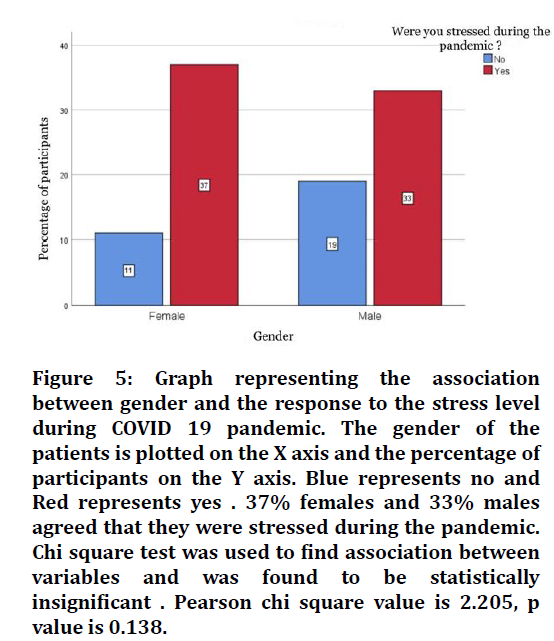
Figure 5. Graph representing the association between gender and the response to the stress level during COVID 19 pandemic. The gender of the patients is plotted on the X axis and the percentage of participants on the Y axis. Blue represents no and Red represents yes . 37% females and 33% males agreed that they were stressed during the pandemic. Chi square test was used to find association between variables and was found to be statistically insignificant . Pearson chi square value is 2.205, p value is 0.138.
Discussion
Figure 1 shows the percentage of participants in each male and female which accounts for about 52% males and 48% females. A similar study conducted by Kate et al also had similar findings where there were 75% females and 24% males involved in the study. Figure 5 tells that most of the population of both males (33%) and females (37%) were stressed during pandemics or any outbreaks. This result is supported by a large proportion (twothirds) of participants were moderately worried about the rapidly spreading and dreadful outbreak. These rates are comparable with past pandemic reports such as SARS [36]. Recent research from China suggests that engaging people in hand hygiene and other self-protective activities was associated with reduced psychological impact of the COVID-19 outbreak, including lower stress and anxiety.
Conclusion
It can be concluded that proper awareness asnd trust must be created among the public for their wellbeing and to work out new strategies to enhance and handle pandemic outbreaks.
References
- https://coronavirus.jhu.edu/map.html
- Bennett P. Risk communication and public health. Oxford University Press 2010; 339.
- J. Holmes B, Henrich N, Hancock S, et al. Communicating with the public during health crises: Experts' experiences and opinions. J Risk Res 2009; 12:793-807.
- Singh A, Purohit BM, Bhambal A, et al. Knowledge, attitudes, and practice regarding infection control measures among dental students in Central India. J Dent Educ 2011; 75:421-427.
- Mohamad E, Tham JS, Ayub SH, et al. Relationship between COVID-19 information sources and attitudes in battling the pandemic among the Malaysian public: Cross-sectional survey study. J Med Internet Res 2020; 22:e23922.
- Mardon A, Mardon C, Baskaran K, et al. Roles of technology during COVID-19. Lulu Press Inc 2020.
- Azlan AA, Hamzah MR, Sern TJ, et al. Public knowledge, attitudes and practices towards COVID-19: A cross-sectional study in Malaysia. PLoS One 2020; 15:e0233668
- Rugarabamu S, Ibrahim M, Byanaku A. Knowledge, attitudes, and practices (KAP) towards COVID-19: A quick online cross-sectional survey among Tanzanian residents. MedRxiv 2020.
- Gostin LO, Viswanathan K, Altevogt BM, et al. Crisis standards of care: A systems framework for catastrophic disaster response: Introduction and CSC framework. National Academies Press 2012; 1
- Yun H. An analysis of school violence victimization among multicultural elementary students. The Institute for Education and Research Gyeongin National University of Education 2019; 39:1–20.
- Zimet GD, Rosberger Z, Fisher WA, et al. Beliefs, behaviors and HPV vaccine: Correcting the myths and the misinformation. Preventive Med 2013; 57:414-8.
- Bish A, Michie S. Demographic and attitudinal determinants of protective behaviours during a pandemic: A review. Br J Health Psychol 2010; 15:797-824
- https://www.simonandschuster.com/books/And-the-People-Stayed-Home-(Family-Book-Coronavirus-Kids-Book-Nature-Book)/Kitty-OMeara/9781734761788
- Rajeshkumar S, Kumar SV, Ramaiah A, et al. Biosynthesis of zinc oxide nanoparticles usingMangifera indica leaves and evaluation of their antioxidant and cytotoxic properties in lung cancer (A549) cells. Enzyme Microb Technol 2018; 117:91–95.
- Nandhini NT, Rajeshkumar S, Mythili S. The possible mechanism of eco-friendly synthesized nanoparticles on hazardous dyes degradation. Biocatal Agric Biotechnol 2019; 19:101138
- Vairavel M, Devaraj E, Shanmugam R. An eco-friendly synthesis of Enterococcus sp.–mediated gold nanoparticle induces cytotoxicity in human colorectal cancer cells. Environ Sci Pollut Res 2020; 27:8166–75.
- Rajkumar PV, Prakasam A, Rajeshkumar S, et al. Green synthesis of silver nanoparticles using Gymnema sylvestre leaf extract and evaluation of its antibacterial activity. South African J Chem Eng 2020; 32:1-4
- Rajasekaran S, Damodharan D, Gopal K, et al. Collective influence of 1-decanol addition, injection pressure and EGR on diesel engine characteristics fueled with diesel/LDPE oil blends. Fuel 2020; 277:118166
- Santhoshkumar J, Sowmya B, Venkat Kumar S, et al. Toxicology evaluation and antidermatophytic activity of silver nanoparticles synthesized using leaf extract of Passiflora caerulea. S Afr J Chem Eng 2019; 29:17–23
- Raj RK. β-Sitosterol-assisted silver nanoparticles activates Nrf2 and triggers mitochondrial apoptosis via oxidative stress in human hepatocellular cancer cell line. J Biomed Mater Res 2020; 108:1899–908.
- Saravanan M, Arokiyaraj S, Lakshmi T, et al. Synthesis of silver nanoparticles from phenerochaete chrysosporium (MTCC-787) and their antibacterial activity against human pathogenic bacteria. Microb Pathog 2018; 117:68–72.
- Gheena S, Ezhilarasan D. Syringic acid triggers reactive oxygen species–mediated cytotoxicity in HepG2 cells. Hum Exp Toxicol 2019; 38:694–702.
- Ezhilarasan D, Sokal E, Najimi M. Hepatic fibrosis: It is time to go with hepatic stellate cell-specific therapeutic targets. Hepatobiliary Pancreat Dis Int 2018; 17:192–7.
- Ezhilarasan D. Oxidative stress is bane in chronic liver diseases: Clinical and experimental perspective. Arab J Gastroenterol 2018; 19:56–64.
- Gomathi AC, Xavier Rajarathinam SR, Mohammed Sadiq A, et al. Anticancer activity of silver nanoparticles synthesized using aqueous fruit shell extract of Tamarindus indica on MCF-7 human breast cancer cell line. J Drug Deliv Sci Technol 2020; 55:101376
- Dua K, Wadhwa R, Singhvi G, et al. The potential of siRNA based drug delivery in respiratory disorders: Recent advances and progress. Drug Dev Res 2019; 80:714–30.
- ND, et al. Comparative estimation of sulfiredoxin levels between chronic periodontitis and healthy patients-A case-control study. J Periodontol Ramesh A, Varghese S, Jayakumar 2018; 89:1241–8.
- Arumugam P, George R, Jayaseelan VP. Aberrations of m6A regulators are associated with tumorigenesis and metastasis in head and neck squamous cell carcinoma. Arch Oral Biol 2021; 122:105030.
- Joseph B, Prasanth CS. Is photodynamic therapy a viable antiviral weapon against COVID-19 in dentistry? Oral Surg Oral Med Oral Pathol Oral Radiol 2021; 132:118–9.
- Ezhilarasan D, Apoorva VS, Ashok Vardhan N. Syzygium cumini extract induced reactive oxygen species-mediated apoptosis in human oral squamous carcinoma cells. J Oral Pathol Med 2019; 48:115–21.
- Duraisamy R, Krishnan CS, Ramasubramanian H, et al. Compatibility of nonoriginal abutments with implants: Evaluation of microgap at the implant-abutment interface, with original and nonoriginal abutments. Implant Dent 2019; 28:289–95
- Gnanavel V, Roopan SM, Rajeshkumar S. Aquaculture: An overview of chemical ecology of seaweeds (food species) in natural products. Aquaculture 2019; 507:1–6.
- Markov A, Thangavelu L, Aravindhan S, et al. Mesenchymal stem/stromal cells as a valuable source for the treatment of immune-mediated disorders. Stem Cell Res Ther 2021; 12:192.
- Institute of Medicine, Board on Global Health, Forum on Microbial Threats. Learning from SARS: Preparing for the Next Disease Outbreak: Workshop Summary. National Academies Press 2004.
- Wheaton MG, Abramowitz JS, Berman NC, et al. Psychological predictors of anxiety in response to the H1N1 (swine flu) pandemic. Cognitive Therapy Res 2012; 36:210-8.
- Saxena SK. Coronavirus disease 2019 (COVID-19): Epidemiology, pathogenesis, diagnosis, and therapeutics. Springer Nature 2020; 213.
Author Info
Aathira CM and Lakshminarayanan Arivarasu*
Department of Pharmacology, Saveetha dental college, Saveetha Institute of Medical and Technical Sciences, Chennai, Tamilnadu, IndiaCitation: Aathira CM, Lakshminarayanan Arivarasu,Psychosocial Behavioural Changes of Public during Pandemics, J Res Med Dent Sci, 2021, 9(10): 83-86
Received: 09-Sep-2021 Accepted: 29-Sep-2021
